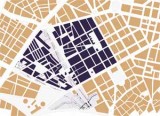Supervisors:
2010
The thesis explores ways of intervention in the area of Metaxourgio in Athens with the aim of coexistence of the elements of diversity (temporal, spatial, functional, cultural). At the same time, it explores the consequences of their implementation in the character of the region, but also in Athens generally, to the extend that the area constitutes part of the historical centre. The current character of the area and the general availability of the state to upgrade it as residence region near the historic centre are taken into consideration as data. The main tool of the study is the emergence of archaeological sites (Dimosion Sima, Iera Odos) and evidence of the recent history of the region (neighbourhood of 19th-20th centuries, factory of Metaxourgio).
In the analysis and recognition of the status quo in the region are taken into account a variety of parameters in order to reach more globally its intense character. Is examined the location of the area in the agglomeration of Athens and the degree of correlation with the wider region of the capital and critical scope positions of city level (Kerameikos archaeological site, Technopolis-Gazi, Omonia Square, Psirri - Plaka – Monastiraki, Botanicos) . Are recorded the historical dimension of the region from ancient times until today, the way of its integration in the plans of the capital of the new Greek state and its evolution during the 19th and 20th century. Are approached the social and anthropological dimension of the region as it stands today and the different groups that make it up within the context of migration, abandonment and obsolescence of the centre on the one hand and the simultaneous settlement of the medium or large income groups on the other hand. Are approached, also, issues of urban fabric and block, as well as their production process in time and space. In this context, are explored of course, the historical, archaeological and urban trails. These traces constitute alignments, whether tangible or intangible waste-products of the past the latent presence of which is inherent in the present contributing to the current produced space and character of the region.
To the designing proposal lead the conclusions of the analysis. Are explored ways of management of urban fabric in order to determine the space produced through the potentially built (block, free building) or unbuilt (street, square) elements of space. Is attempted the control of the conflictual relationships developed in components in such a way that the differentiation of one changes the balance of the system. General and specific alignments of urban fabric and links of points of special interest are determined. As critical positions in the region are defined two zones transverse in Piraeus Street: Giatrakou Square and the building of Metaxourgio, and the zone which is identified with Dimosion Sima of the ancient city. However, equally critical is the area located between the two as a transition area.
The questioning included in the proposal concerns the coexistence in space and time of data obtained at a different time, in different social and cultural contexts since the region constitutes a palimpsest. The objective is the modern reading of urban space through these points of difference.
